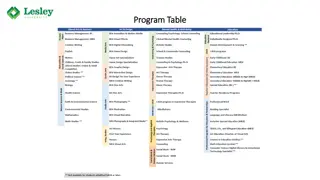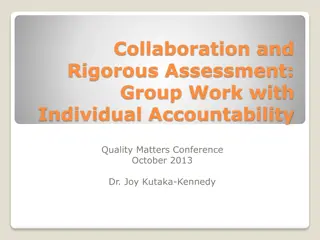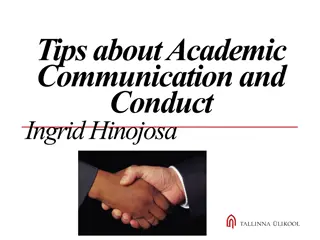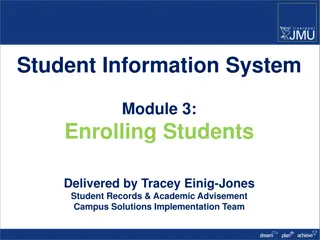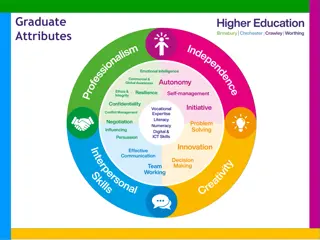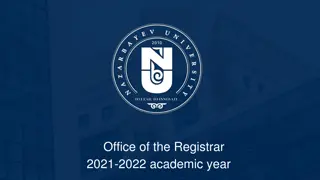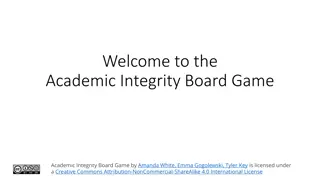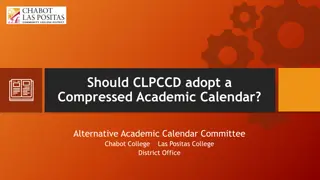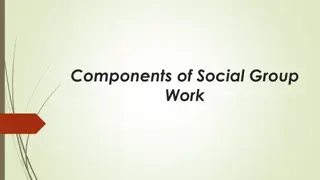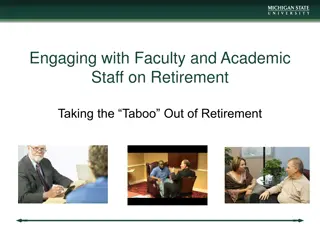Strategies for Successful Group Work in Academic Settings
Learn to identify value goals for your group, outline detailed strategies for achieving them, and develop plans to avoid common group pitfalls such as groupthink. Utilize the scientific method to test and refine your strategies throughout the semester for optimal group performance.
Download Presentation

Please find below an Image/Link to download the presentation.
The content on the website is provided AS IS for your information and personal use only. It may not be sold, licensed, or shared on other websites without obtaining consent from the author. Download presentation by click this link. If you encounter any issues during the download, it is possible that the publisher has removed the file from their server.
E N D
Presentation Transcript
Pitfalls to Avoid in Group Work William J. Frey ADEM University of PR - Mayaguez
Your tasks Exercise 1 Identify 3 to 5 value goals for your group for this semester. Outline strategies that describe in detail how you are going to realize these values. Exercise 2 Describe briefly your understanding of the group pitfalls outlined in this presentation Develop plans or strategies for avoiding them You plan should be specific enough to serve as a scientific hypothesis; as the semester unfolds and challenges emerge, you should be able to confirm or reject your strategies in terms of whether they work, i.e., prevent or minimize the pitfall
Scientific Method The scientific method has you establish the problem, develop hypotheses to solve the problem, test these hypotheses, and confirm or reject them on the basis of the results. Your problem What procedures will realize your value goals? What strategies will prevent the three group pitfalls? Formulate your value procedures and pitfall prevention strategies as scientific hypotheses that are testable in the context of classroom experience
Your Task In your preliminary self-evaluations, describe your procedures for realizing value through your group work. Use the suggestions in the module to get started. In your preliminary self-evaluation, describe your strategies for avoiding groupthink, group polarization, and going to Abilene. Use the suggestions provided in the module to get started In the mid-semester audit, you will assess the effectiveness of your procedures and strategies If they work, describe in detail how they work If they fail, reformulate them. Then test the new versions as hypotheses
Groupthink Groupthink = a situation in which groups come to agreement at the expense of critical thinking. Harris, Pritchard, Rabins. Engineering Ethics: Concepts and Cases, 112-113. Irving Janis. Groupthink: Psychological Studies of Policy Decisions and Fiascoes, 2ndEd. (Boston, Houghton Mifflin, 1982). Eight signs of groupthink (quoted from Harris et al): (1) an illusion of invulnerability, (2) a strong we feeling that views outsiders as adversaries or enemies, (3) rationalizations that tend to shift responsibility to others, (4) an illusion of morality that assumes the inherent morality of the group, (5) a tendency of individual members toward self-censorship, (6) an illusion of unanimity, construing silence of a group member as consent, (7) an application of direct pressure on those who show signs of disagreement, and (8) mindguarding, protecting the group from dissenting views. Quoted with some omissions from Harris et al 113.
To avoid groupthink "The leader of a policy-forming group should assign the role of critical evaluator to each member, encouraging the group to give high priority to airing objections and doubts." "The leaders in an organization's hierarchy, when assigning a policy- planning mission to a group, should be impartial instead of stating preferences and expectations at the outset." "Throughout the period when the feasibility and effectiveness of policy alternatives are being surveyed, the policy-making group should from time to time divide into two or more subgroups to meet separately...." One or more outside experts or qualified colleagues within the organization who are not core members of the policy-making group should be invited to each meeting ...and should be encouraged to challenge the views of the core members." "At every meeting devoted to evaluating policy alternatives, at least one member should be assigned the role of devil's advocate. Janis, Groupthink: Psychological Studies of Policy Decisions and Fiascoes, 2ndEd., 262-271
Group Polarization A lot of people in Puerto Rico oppose the Via Verde, a proposed gas pipeline from Ponce to San Juan via Arecibo. There are good arguments for this But those opposing have characterized the Via Verde as a fraud and a deception. This is an example of polarization. Weston: Our moral values often diverge .We need to decide how to go on when we ourselves feel divided, and we need to be able to go on together when our values diverge. One problem is that we often exaggerate our divergences, making them much worse than they might be. We polarize values. Group polarization occurs when members exaggerate non-agreement (brought about by different values or different views of given values) and convert it into disagreement and opposition.
Signs of Group Polarization One side is right, the other wrong One side is good, the other evil. One side propounds the truth, the other is mired in falsity One side proceeds morally, the other by means of force, fraud, deception, or manipulation
Why is group polarization an unsuccessful strategy By presenting non-agreement as opposition, group polarization converts it into a zero sum game: one side (hopefully ours) must win, the other must lose. This rules out full integration (solution where everybody wins) and partial integration (compromises where each party gives a bit) as solution routes. All conflicts are framed as trade offs where the views of one s side are pitted in a competition against those of the other. The victory of one side is the defeat of the other
Successful strategies for Compromise Negotiate Interests, not Positions. It is usually easier to integrate basic interests than specific positions. Reframing non-agreements this way unlocks integrations and compromises. Expanding the Pie. Many times constraints bounding a situation can be pushed back through negotiation or innovation. Nonspecific Compensation. One side makes a concession to the other but is compensated in another round by a corresponding concession from the other players. (I lose this time, but I can call the shots in the next round.) Logrolling. Each party lowers their aspirations on items that are of less interest to them and trade off a concession on a less important item for a concession on a more important item. Cost-Cutting. One party agrees to reduce its aspirations on a particular thing. The other party agrees to compensate the first for the costs created by the reduction. Bridging. Finding a higher order interest on which both parties agree, and then constructing a solution that serves that agreed-upon interest. Taken from Good Computing. Textbook manuscript developed by Chuck Huff, William Frey, and Jose Cruz.
Your responsibility Always aim first for a value-integrative, win/win solution. If this doesn t work look for ways to compromise. Use the ideas suggested on the previous slide. Only as a last resort should you trade off interests or proposals. And this should be done with the commitment that the loser stays in the game and will prevail in the next no-win situation.
Going to Abilene The story of a family who would all rather have stayed at home on a hot, summer Texas day. Instead, they wound up traveling 100 miles to and from Abilene to have lunch at a cafeteria none of them liked. When they returned, they realized that none of them wanted to go to Abilene. Because of faulty communication, the group wound up doing what nobody wanted to do. Each conceded because he or she mistakenly thought everybody else wanted to do this. Going to Abilene consists of making unnecessary compromises or concessions because of a breakdown in group communication.
Strategies for Avoiding Abilene At the end of the group decision-making process, carry out an anonymous survey asking participants if anything was left out that they were reluctant to put before the group. Or conduct this anonymous survey individually before discussion begins. After the discussion concludes, consult the survey and see if there are any hidden profiles. (Unexpressed interests or ideas.) Designate one member a devil s advocate who is responsible for criticizing the group s decision, no matter what. Choose someone creative who can view a situation from different frames.
What groups can do well They introduce creativity Different members frame a given situation differently They assemble dispersed knowledge and expertise They can generate mutual support and solidarity But this assumes a basis of trust and reasonableness as well as carefully developed procedures of open communication Good communication is the best remedy to the three pitfalls of group work: groupthink, group polarization, and going to Abilene



